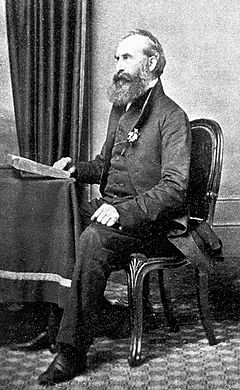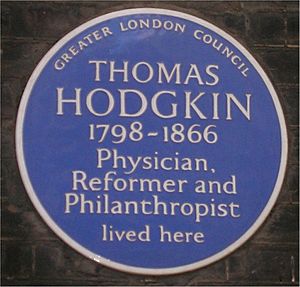Thomas Hodgkin facts for kids
Quick facts for kids
Thomas Hodgkin
|
|
|---|---|
 |
|
| Born | 17 August 1798 |
| Died | 5 April 1866 (aged 67) Jaffa, Ottoman Palestine
|
| Education | University of Edinburgh |
| Parent(s) |
|
| Known for | Preventive medicine First account of Hodgkin's Disease |
| Scientific career | |
| Fields | Pathologist |
| Signature | |
 |
|
Thomas Hodgkin (17 August 1798 – 5 April 1866) was a British doctor. He was known as one of the most important pathologists of his time. He was also a pioneer in preventive medicine, which focuses on stopping diseases before they start.
Today, he is most famous for being the first to describe Hodgkin's disease in 1832. This is a type of lymphoma, which is a blood disease. Hodgkin's work helped start a new era where pathologists worked closely with doctors to treat patients. He worked at Guy's Hospital in London.
Contents
Early Life and Education
Thomas Hodgkin was born into a Quaker family in Pentonville, England. His father was John Hodgkin. Thomas and his brother John Hodgkin were taught at home.
In 1816, Thomas worked as a private secretary for William Allen. He wanted to become an apothecary, which was a way to enter medicine back then. Later, he worked with his apothecary cousin, John Glaisyer, in Brighton. When he turned 21, he inherited money, which gave him some financial freedom.
Medical Training and Travel
In September 1819, Hodgkin started studying at St. Thomas's and Guy's Medical School. He spent a year learning from doctors and surgeons in the hospital wards. He also attended lectures, especially by Astley Cooper.
He then studied at the University of Edinburgh. There, he was impressed by lecturers like Andrew Duncan, the younger, and Robert Jameson. His first published paper was about the spleen. While studying, he joined the Royal Medical Society.
In 1821, Hodgkin traveled to France. He learned to use the stethoscope, a new invention by René Laennec. He also learned about the careful way Pierre Charles Alexandre Louis studied diseases using statistics. In 1823, Hodgkin earned his M.D. from the University of Edinburgh Medical School. His main project was about how animals absorb things.
While in Paris, Hodgkin met Benjamin Thorpe, a banker who had tuberculosis. Hodgkin became his doctor and Thorpe got better. This led to Hodgkin becoming the doctor for Abraham Montefiore, who was married to a daughter of Mayer Amschel Rothschild. Hodgkin traveled with them to Italy. Abraham was very sick with tuberculosis and died in 1824. However, Hodgkin became lifelong friends with Abraham's brother, Moses Montefiore.
Hodgkin stayed in Paris from 1824 to 1825. He met important medical experts like the Edwards brothers, William-Frédéric Edwards and Henri Milne Edwards, who studied how the body works. He also met Achille-Louis Foville, a brain doctor.
Career at Guy's Hospital
In 1825, Hodgkin started working at Guy's Hospital as a volunteer. In 1826, he became the curator of the museum there. He also performed autopsies, which means examining bodies after death to understand diseases. This work, called morbid anatomy (now anatomical pathology), helped him build his reputation.
However, Hodgkin's hospital career ended in 1837. He had disagreements with Benjamin Harrison, a powerful hospital administrator. Harrison did not like Hodgkin's modern ideas. He also did not like Hodgkin's support for the new University College London. Hodgkin was not given a promotion he wanted. His friends tried to help, but the hospital governors voted against him. The position went to another doctor, Benjamin Guy Babington. Hodgkin then started working as a private doctor. In 1840, he attended the World Anti-Slavery Convention in London.
Lecturer at St. Thomas's Hospital
In 1842, Hodgkin was asked to teach at St. Thomas's Hospital. After Guy's and St. Thomas's hospitals separated in 1825, St. Thomas's medical school was not as strong. Hodgkin was brought in to improve it. He found new lecturers like Marshall Hall and George Gregory. Hodgkin also gave lectures himself. He used his experience from Guy's to improve the museum and start a group for discussing medical cases. However, he was not asked to continue teaching after one year.
Later Life and Travels
Around 1847, Hodgkin became the guardian of an Aboriginal Australian teenager named Warrulan. Warrulan had been brought to England in 1845. Hodgkin arranged for him to go to the Quaker Sibford School.
In 1850, Hodgkin married Sarah Frances Scaife, a widow. They did not have children. When Lady Montefiore died in 1862, Hodgkin promised her that he would travel with her husband, Moses Montefiore, in the future. In 1866, he went with Moses Montefiore to Palestine. There, Hodgkin became sick with dysentery and died on April 4, 1866. He was buried in Jaffa.
Interests and Activism
Like many Quakers, Hodgkin cared deeply about ending slavery and protecting native peoples around the world from the negative effects of colonization. He took his own actions when he felt other groups were not doing enough.
Ethnology and Languages
Hodgkin was interested in both the physical and cultural aspects of different peoples, which is now called ethnology. As the museum curator at Guy's, he collected items from people worldwide. In 1827, he wrote about his ideas on "civilisation". He believed that languages were important clues to human origins and should be saved if they were in danger. He helped start the Aborigines Protection Society.
Hodgkin believed language was connected to race. In 1838, he encouraged W. F. Edwards to create a French society with similar goals. This led to the Société Ethnologique de Paris in 1839. In 1843, the Ethnological Society of London was formed, focusing more on science and language than missionary work.
Colonization in Africa
Hodgkin supported Liberia when it was first founded. He thought it was better than Sierra Leone. By supporting Elliott Cresson and the American Colonization Society, he went against the common views of Quakers and abolitionists. He tried to help resolve disagreements between William Lloyd Garrison, an American abolitionist, and Cresson. Hodgkin supported the British African Colonization Society. This made him feel alone from his usual allies.
Hudson's Bay Company Concerns
Around 1836–37, Hodgkin became involved in a campaign about the Hudson's Bay Company. His friend Richard King had written a book about his travels in northern Canada. King wanted another expedition, which Hodgkin supported. The Hudson's Bay Company's license was going to expire soon, and there were important business interests involved. King's book included a part Hodgkin wrote about the company's lack of care for the native peoples of western Canada.
Hodgkin then discussed the company's behavior with Benjamin Harrison, the Treasurer of Guy's Hospital. This caused problems because Harrison was also a leader in the Hudson's Bay Company. Hodgkin's concerns about the native peoples in the company's territory continued. He wrote to Sir George Simpson and published his views in the Intelligencer of the Aborigines Protection Society.
Medical Discoveries and Writings
Hodgkin worked with Joseph Jackson Lister, who in 1830 created new designs for microscopes that made images clearer. Hodgkin and Lister had already published research on body tissues using Lister's new microscope. They studied the "globule hypothesis," a theory that tissues were made of tiny balls. They disagreed, saying these "globules" were just optical illusions. This debate continued for ten years. Eventually, Hodgkin and Lister's view was accepted. Their 1827 paper is considered the start of modern histology, the study of tissues.
Hodgkin described the disease now named after him, Hodgkin lymphoma, in 1832. He wrote about it in a paper called On Some Morbid Appearances of the Absorbent Glands and Spleen. Thirty-three years later, another British doctor, Samuel Wilks, recognized Hodgkin's original description. Hodgkin lymphoma is a type of cancer that causes swelling of lymphoid tissue, the spleen, and the liver. It can also spread to other tissues.
Hodgkin published his Lectures on Morbid Anatomy in 1836 and 1840. His most important contribution to teaching pathology was his two-volume work from 1829, The Morbid Anatomy of Serous and Mucous Membranes. This book became a classic in modern pathology.
Hodgkin was one of the first people to support preventive medicine. He published a book called On the Means of Promoting and Preserving Health in 1841. He also made other early observations, such as the first description of acute appendicitis. He also described the shape of red blood cells and the stripes on muscle fibers.
Hodgkin also helped translate a French book by William-Frédéric Edwards called On the Influence of Physical Agents on Life (1832). This book was about how physical forces affect living things. Hodgkin's English version included an extra 200 pages of his own papers and collaborations, making it much more than just a translation.
Legacy
There is a blue plaque on Hodgkin's house in Bedford Square, London. The Friends' School, Hobart in Australia named one of its school houses after him. The Hodgkin Building at King's College London School of Medicine is also named in his honor.
Images for kids
See also
 In Spanish: Thomas Hodgkin para niños
In Spanish: Thomas Hodgkin para niños



